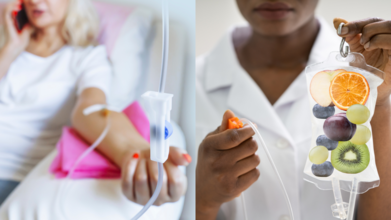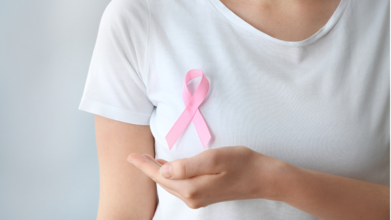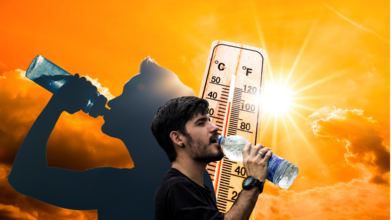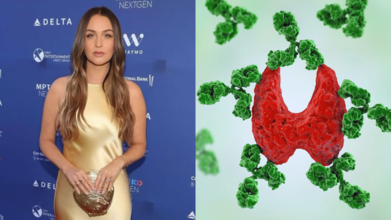- Health Conditions A-Z
- Health & Wellness
- Nutrition
- Fitness
- Health News
- Ayurveda
- Videos
- Medicine A-Z
- Parenting
- Web Stories
The Truth About Vitamin Therapy for Perfect Skin and Lush Hair

From glossy Instagram reels to glossy foreheads, vitamin therapy has become the darling of beauty trends. It promises “instant glow” and “Rapunzel hair”, often in the form of IV drips or colourful capsules. But is it really a miracle elixir or just a very expensive placebo with better marketing? Dermatologists say it is a bit of both.
Vitamin therapy acts as a protective shield for your cells. According to Dr Pravin Banodkar, Co-Founder and Lead Dermatologist at Skin Beyond Borders, our skin and hair face daily assaults from pollution and dust to stress and hormonal changes. Over time, these factors wear down cell health, slow growth, and accelerate signs of ageing. For skin, that means hyperpigmentation and dullness. For hair, it often means thinning and increased shedding.
Vitamin therapy works by giving cells a protective boost through antioxidants, which fight off damage and keep things running smoothly. “It helps reverse some of the impact by preventing damage to hair cells and boosting repair processes,” Dr Banodkar explains.
When Life Gets in the Way of Nutrition
If your diet often looks like coffee for breakfast, desk snacks for lunch, and “something quick” for dinner, your skin and hair may already be paying the price. Dr Banodkar says that people with hectic routines often develop deficiencies in vitamins A, C, D, and essential micronutrients. Left unchecked, these gaps can shorten the hair growth cycle and weaken the skin’s barrier function.
For such cases, vitamin therapy – oral, topical, or even targeted IV – can help fill the gaps. But if you already eat a balanced diet and nourish yourself consistently, “high-dose supplementation and IV drips offer no extra benefit,” he adds. Meaning, if your body is not missing it, megadoses will not suddenly help.
Micronutrients
One of the buzzier developments in dermatology is the “micronutrient concept”, feeding the hair bulb with targeted nutrients to prolong the growth phase (known as the anagen phase). Examples include:
- Vitamin A: Promotes skin cell turnover, reduces acne
- Vitamin C: Boosts collagen production, brightens skin
- Vitamin E: Antioxidant that aids repair
- Biotin (B7): Supports hair and nail strength
- Vitamin D: Crucial for follicle health and immune function
- Niacin (B3): Improves skin texture and barrier
Used strategically, these can improve skin repair and help hair grow longer before shedding. But more is not always better.
The Hype vs The Hard Truth
Dr Aseem Sharma, Director and Chief Dermatologist at Skin Saga Centre for Dermatology, points out that vitamin therapy has its place but not as a monthly beauty ritual for those without a medical need. “If you are genuinely deficient in D, B12, or iron, correcting that can transform skin and hair. But topping up levels that are already normal rarely produces dramatic results,” he says.
Biotin, for example, is often marketed as the holy grail for hair growth. In reality, unless you are deficient, which is rare in healthy adults, it won’t magically transform thin hair into thick locks. Hair growth depends on protein intake, hormones, follicle health, and micronutrients working together.
Antioxidants
Vitami and glutathione can protect skin and hair from oxidative stress, the kind that speeds up ageing and damages follicles. But their benefits plateau once the body has enough. Overuse can even cause side effects, especially with fat-soluble vitamins that linger in the system. In other words, popping a week’s worth of supplements in one sitting won’t give you a week’s worth of glow; it might just give you an upset stomach.
Should You Book That Vitamin Drip?
Both Dr Banodkar and Dr Sharma agree: start with your diet. Focus on whole foods, adequate protein, and a rainbow of fruits and vegetables. Address specific deficiencies through tests, not guesswork. Save the IV drips for genuine medical needs, not pre-party touch-ups.
Vitamin therapy can be a useful support act, especially for people with nutritional gaps, malabsorption issues, or recovery needs. But it is not the headliner. Your real glow comes from a healthy lifestyle, consistent skincare, and, yes, the occasional salad that is not just for show.
Common Anti-Nausea Pill May Reduce Recurrence and Death in Aggressive Breast Cancers, Study

In breast cancer research, the search for effective treatments is constant. At times, the most promising candidates are not newly developed drugs but existing medications whose potential benefits have remained hidden in plain sight. A recent study suggests that a pill usually prescribed to calm queasy stomachs could also be helping women live longer, particularly those battling one of the most aggressive forms of the disease.
The medication in question is aprepitant, a drug doctors have been doling out for years to keep chemotherapy-induced nausea and vomiting in check. But according to researchers from Monash University in Australia and the Norwegian Institute of Public Health, this humble anti-nausea capsule could be pulling off an unexpected encore performance by lowering the risk of breast cancer returning and even cutting the risk of death.
How the discovery unfolded
The research team did not stumble across this by accident; they went digging through an impressive amount of data. They analysed the medical records of 13,811 Norwegian women diagnosed with early-stage breast cancer between 2008 and 2020. Every single one had undergone chemotherapy, and all had been prescribed something to combat its stomach-churning side effects.When the numbers were crunched, aprepitant stood out. Women who took it had an 11 per cent lower chance of their cancer making an unwelcome comeback and a 17 per cent lower chance of dying from breast cancer over a decade. Other anti-nausea meds did not show the same life-saving magic.
The triple negative twist
The story gets even more interesting when you zoom in on women with triple negative breast cancer (TNBC) — a subtype known for its aggression, fewer targeted treatments, and generally poorer prognosis. For this group, the benefits of aprepitant were even bigger. The study found a 34 per cent drop in recurrence and a 39 per cent drop in deaths linked to breast cancer.Dr Aeson Chang from the Monash Institute of Pharmaceutical Sciences, a senior author on the study, explains why this matters so much. Triple negative breast cancer does not give many treatment tools to work with. That is why finding new uses for safe, existing drugs could be a fast-track way to help patients.
A drug repurposing opportunity
Repurposing medications is not new; after all, sildenafil was once meant for chest pain before its other, more famous use took off. In this case, aprepitant has already cleared safety hurdles and been in use for years. That makes it an appealing candidate for rapid integration into cancer care, provided future research confirms its benefits.
However, more work needs to be done before prescribing rules changes. Triple negative breast cancer is notoriously tough to treat. With around 3,000 new cases diagnosed annually in Australia alone, every potential new pathway matters. Researchers would like to see more studies to confirm if aprepitant really can prevent relapse and if so, we may need to rethink anti-nausea prescribing guidelines altogether.
Beyond the guidelines
Currently, aprepitant is only recommended for patients whose chemotherapy carries a high risk of causing nausea and vomiting. But nausea is a common visitor for most people going through systemic treatment; up to 60 per cent experience it. The study hints that more patients could benefit from aprepitant’s unexpected bonus effect.
Dr Chang believes this opens the door to testing whether a wider rollout could improve survival rates. Aprepitant is usually taken during the first three days of chemotherapy. Now they are wondering, what if longer-term use made the benefits even bigger?
The data detectives
The team’s first author, Dr Edoardo Botteri, a pharmacoepidemiologist at the Norwegian Institute of Public Health, says the large, population-based approach was key. Looking at such a big group over a long period gave them the first solid evidence of this potential connection.Where next?
Before you rush to the pharmacy, here is the reality check. This study shows an association, not absolute proof of cause and effect. More clinical trials will be needed to see if aprepitant directly influences cancer biology or if the benefit comes from another, related factor.
Still, the idea that a simple anti-nausea pill could be doing double duty is an enticing one. It is a reminder that in medicine, sometimes the best discoveries do not come from flashy new drugs but from looking again at what is already in our medicine cabinets.
If future research backs it up, doctors might start prescribing it not just to soothe stomachs but also to boost survival odds, especially for those facing the toughest breast cancer battles.
Attention, Brits! This Is How Much Water You Should Really Be Glugging In A Heatwave

During a heatwave, adequate hydration becomes a health priority rather than a casual choice. High temperatures increase the body’s fluid loss through sweat, and without sufficient water intake, the risk of dehydration and heat-related illnesses rises significantly.
The Heatwave Hydration Rule
The NHS says your daily water needs depend on a few factors like your body weight, activity levels, and how much you are sweating like a contestant in a chilli-eating contest. When the mercury rises, so should your water intake. In short, a balmy 32 degrees Celsius is not the day to sip daintily on a single glass of H2O.According to Dr Sonali Ruder, who works as an emergency doctor, a good general rule is to drink about half your body weight in ounces of water. For example, if you weigh 150 pounds (around 68 kg), that is roughly 75 ounces (just over 2 litres) spread throughout the day. But if you are jogging in the park, hauling shopping in the midday sun, or simply existing in a non-air-conditioned flat, you will need to top that up.
Pregnant or breastfeeding? Your body’s running on extra hydration demands, so keep the bottle handy.
Tips to Keep the Water Flowing
The NHS recommends sticking to plain water for the best hydration hit. Chugging in big gulps is not as helpful as sipping regularly, so think of yourself as a plant that needs steady watering. If you have been sweating more than usual, from exercise or just standing still in the heat, up your intake.Invest in a large, insulated bottle that keeps your drink icy cold, and take it everywhere. You are more likely to sip without thinking if it is right there on your desk, in your bag, or even next to the kettle.
The Dark Side of Dehydration
Skipping water in a heatwave is like forgetting to charge your phone before a long day, except your body is much less forgiving. Dehydration happens when you are losing more fluids than you are taking in. Without enough water, your body cannot function at its best.Signs you might be running on empty include:
- Thirst (obvious, but often ignored)
- Dark yellow or strong-smelling urine
- Headaches and dizziness
- Fatigue or confusion
- Dry mouth, lips, and eyes
Left unchecked, dehydration can lead to heat exhaustion or heatstroke, which is a fast-track ticket to the hospital.
Can You Overdo It?
Surprisingly, yes. While staying hydrated is crucial, overhydrating can also cause problems. Drinking far too much water in a short space of time can dilute the sodium in your blood, leading to a condition called hyponatraemia. Symptoms include nausea, headaches, confusion, and, in extreme cases, seizures.
This is rare, but it is worth knowing that balance is key. Your goal is steady hydration, not winning a personal best in “litres consumed in an hour”. In the British heatwave, your best defence is a smart hydration plan. Sip water consistently, up your intake if you are sweating, and pay attention to your body’s signals. Keep your urine pale, your energy steady, and your insulated bottle close by.
‘Grey’s Anatomy’ Star Opens Up About Hashimoto’s Hypothyroidism: Know How This Autoimmune Disorder Can Impact Body and Mind

On her “Call It What It Is” podcast with co-star Jessica Capshaw, Grey’s Anatomy star Camilla Luddington revealed she had recently been diagnosed with Hashimoto’s hypothyroidism, an autoimmune condition that quietly messes with your thyroid and, by extension, your entire energy system.
Best known as Dr Jo Wilson, the 41-year-old Luddington admitted she had brushed off her constant tiredness, sluggishness, and need to curl up in bed as signs of getting older or hitting perimenopause. “Makes you a little slothy,” she joked, only half-serious. The truth was more complex and involved a surprisingly common yet under-discussed health disorder.
When “just tired” is something more
It started with a routine blood test. Her doctor spotted “one little thing” and, before she knew it, dropped the phrase “autoimmune disease” into the conversation. But the reassurance came quickly: Hashimoto’s is very common, especially among women in middle age.
Still, common does not mean harmless. Reportedly, Hashimoto’s slowly attacks the thyroid gland, the butterfly-shaped organ at the base of your neck that produces hormones controlling metabolism, temperature regulation, and a surprising list of bodily functions. Over time, the immune system’s misguided attack leads to a drop in hormone production, setting the stage for hypothyroidism.
The symptoms
Fatigue, dry skin, weight gain, and do not forget the cold intolerance, hair loss, and brain fog. According to the Mayo Clinic, these are just the tip of the symptom iceberg for Hashimoto’s, which can also cause constipation, muscle aches, joint pain, irregular menstrual cycles, depression, brittle nails, and even an enlarged thyroid (goitre). Sometimes symptoms creep in so gradually that people do not realise something is wrong.Luddington recognised several of these signs in hindsight, though she had been quick to explain them away. Now, with a diagnosis in hand, she’s on medication and back to exercising — a reminder that treatment can help restore some balance, even if there’s no cure.
Watch the video here:
Who’s at risk and why
Hashimoto’s can strike anyone, but middle-aged women top the risk list. Genetics may be part of the puzzle, along with environmental triggers like infections, chronic stress, or even radiation exposure.
And while the disease typically develops slowly, its reach is wide. If untreated, it can snowball into complications like heart problems, fertility issues, poor pregnancy outcomes, or a rare and life-threatening state called myxedema, where extreme hypothyroidism leads to unconsciousness.
The mental health connection
Hashimoto’s is not just a physical game-changer. Because thyroid hormones influence brain chemistry, untreated hypothyroidism can cause depression, anxiety, and severe mood changes. Luddington herself described feeling constantly run down, with a fatigue so deep it impacted her day-to-day life. This mental strain often gets overlooked, especially when symptoms overlap with other conditions.Treatment that works
Reportedly, thyroid hormone replacement therapy is the gold standard for treatment, often in the form of a daily pill that restores hormone levels. When managed well, it can make symptoms fade into the background. Lifestyle adjustments, such as regular exercise, good sleep habits, and balanced nutrition, can also help.
Luddington’s story is proof that a proper diagnosis can be life-changing and that even those with hectic Hollywood schedules need to listen to their bodies.
Why you shouldn’t ignore “little” symptoms
Feeling tired is not unusual. But when exhaustion comes with hair loss, weight changes, and a tendency to wear sweaters in 25-degree weather, it is worth checking your thyroid. As Luddington learnt, what seems like ordinary wear and tear can sometimes be a hormonal SOS.
If left untreated, Hashimoto’s can quietly chip away at your health for years, leading to cardiovascular risks, mental health struggles, and long-term organ strain. That is why timely diagnosis and treatment are not just medical niceties; they are essential.
The message is simple: fatigue is not always “just life”. Sometimes, it is your body asking for help and that call deserves an answer.
© 2024 Bennett, Coleman & Company Limited

